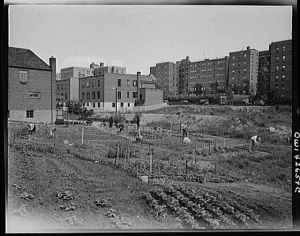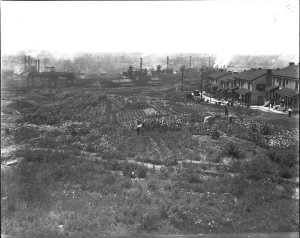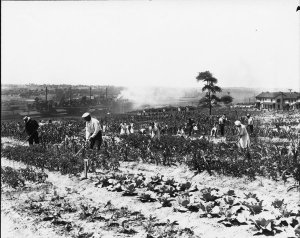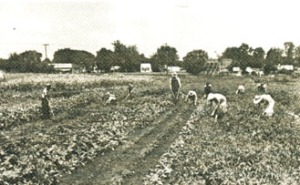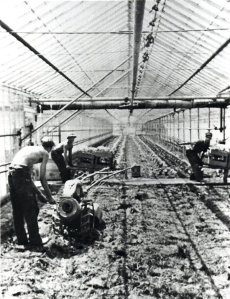Gardeners fend off starvation in Berlin, 1946.
At the beginning of World War II, victory gardens began to emerge again. Some of these gardens had started as depression relief gardens, others were gardens from the first world war. There were also many were new gardens, carved out of vacant lots, back yards, and city parks. The War Food Administration created a National Victory Garden Program, which set five maine goals.
1. lessen demand on commercial vegetable supplies and thus make more available to the Armed Forces and lend-lease programs.
2. reduce demand on strategic materials used in food processing and canning
3. ease the burden on railroads transporting war munitions by releasing produce carriers
4. maintain the vitality and morale of Americans on the home front through the production of nutritious vegetables outdoors
5. preserve fruit and vegetables for future use when shortages might become worse (Bassett 1981)
Some victory gardeners proudly distplaying their vegetables. 1942 or 1943.
Library of Congress Digital Photography Collection.
Gardens began, once again, to change in the eyes of Americans, just as they had in the first world war. They were no longer just for the poor, or for those who could not feed themselves, but for everyone. Gardening became popular not only for food security, but for it mental and physical health benefits and its benefits to the community. Gardens gave a feel of productivity that citizens on the home-front needed. A garden plot feels much more useful, productive, and important than a vacant lot or lawn. With loved one off at war, it greatly improved morale to have an outlet for the patriotism, fear, and anxiety that many Americans felt about the war. In 1942, about 5.5 million gardeners participated in the war garden effort, making seed package sales rise 300%. The USDA estimated over 20 million garden plots were planted with an estimated 9-10 million pounds of fruit and vegetables grown a year, 44 percent of the fresh vegetables in the United States. (Bassett 1981) In 1943, American families bought 315,000 pressure cookers for canning vegetables up from 66,000 in 1942 (Wessels).
Jeffersontown, Kentucky. The Jefferson County ommunity cannery, started by the WPA (Work Projects Administration). Canning beans and greens raised in a victory garden. It costs three cents each for cans and two cents per can for use of the pressure cooker. June 1943.
During the war years, Americans discovered and benefited from gardening’s many advantages. It was stylish to garden. This didn’t last long, however. Once the war ended, there was an overall decline in interest in gardening as life returned to normal in the US and the baby boomer era began. Many victory gardens were grown on loaned property, which needed to be returned in peacetime.
But urban gardens were not gone…..
Poster circulated by the New York City Work Projects Administration, between 1941 and 1943. Artist: Herbert Bayer
J. H. Burdet, National Garden Bureau. 1939-1945.
This is a garden built out of a bomb crater in London, 1943
Victory gardening on the Charles Schwab estate. New York, New York. June 1944.
May 1943, New York, New York. Children of the New York City Children’s Aid Society work on their victory gardens at the West Side Center.
Victory gardening at Forest Hills, Queens. New York, New York. June 1944.
Washington, D.C. A resident of the Southwest section and her Victory garden. June 1943.
Washington, D.C. Vice President Henry A. Wallace in his victory garden. Aug. 1942.
So, wait… food… I can grow it in my yard? That’s like a lot of work right? But you know what? It helps the war effort.
“To save gasoline, they use a horse and plow and humble farm implements. It is anything but organic. We see every kind of pest, worm and disease that can affect the garden. Rick sprays various noxious looking chemicals on the vegetables without wearing a face mask or gloves.
“A victory garden is like a share in an airplane factory, the film opening tells us. It is also a vitamin factory that will keep Americans strong. The film ends on a patriotic note, ‘No Work, No Victory!’ Bear that in mind all you Victory Gardeners and Work! For Victory! A no-nonsense, non-idealized look at what it is like to have to really grow your own food.”
Stock Footage: MOT 1943\: COMMUNITY VICTORY GARDEN\: WS People preparing soil for planting in empty lot of rural neighborhood turning soil w/ hoes. Young adult women tilling soil. WWII 49309081_043
Stock Footage: MOT 1943\: DRAMATIZATION\: PERSONAL VICTORY GARDEN\: * EXT Seed store. Man walking into store CU War Gardens poster man buying seeds hoe saying only way to get what you want to eat grow it yourself. CU Seed packets on counter. Food shortage WWII 49309081_042
1942 Barney Bear’s Victory Garden
Similar Garden Projects
PASADENA, CA – As localization becomes increasingly popular due to the continued rise in gas prices and with the cost of living skyrocketing in the southland, Reginald Miller shows us one mans way of saving money by bringing back an alternate method of putting food on the table the old fashioned way.
Blair Randall, program director for San Francisco’s Garden for the Environment, proposes re-implementing the WWI and WWII Victory Gardens as a way to gain independence from our current food system with Victory Gardens 07+. You can check out the Victory Gardens 07+ project in San Fran here.
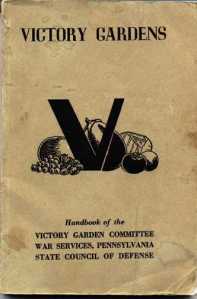
Handbook of the Victory Garden Committee War Services, Pennsylvania State Council of Defense. April, 1944
Use the references below to learn more about victory gardens during World War II:
Bassett, Thomas J. “Reaping on the Margins: A Century of Community Gardening in
America.” Landscape, 1981 v25 n2. 1-8.
Buswell, Sherley. 1980. “Victory Gardens: The Garden Warriors of 1942, Winning through 1943.” City Farmer: Vancouver, BC. 3(2).
http://www.cityfarmer.org/victgarA57.html#vict%20garden1
Goldstein, Libby J. “Philadelphia’s Community Garden History.” City Farmer, 1997.
http://www.cityfarmer.org/Phillyhistory10.html
Very brief history of Philly’s community gardens in the last century.
Helphand, Kenneth. 2006. Defiant gardens : making gardens in wartime. San Antonio, Tex. : Trinity University Press.
Lawson, Laura. 2005. City Bountiful: A Century of Community Gardening in America. University of California Press. SB457.3 .L39 2005
Levine, Ketzel. 2006. Tending “Defiant Gardens” During Wartime. NPR. http://www.npr.org/templates/story/story.php?storyId=5435131
Pennsylvania State Council of Defense. Handbook of the Victory Garden Committee War Services. 1944.
http://www.earthlypursuits.com/victorygardhandbook/VGHv.htm
An online version of a gardening handbook first published in 1944 for victory gardeners.
Tucker, David M. Kitchen Gardening in America: A History. Ames, Iowa: Iowa State
University Press, 1993.
Web, Margaret Rainbow. “Grandpa’s Victory Garden.” City Farmer.
http://www.cityfarmer.org/grandpasVG.html
Remembering grandfather’s victory garden.
Wessel Living History Farm. Farming in the 40s:Victory Gardens .http://www.livinghistoryfarm.org/farminginthe40s/crops_02.html
A History of the Victory Garden.
http://www.victoryseeds.com/TheVictoryGarden/page2.html
Fruit From Washington – Fruit Harvest and Other Historic Posters from World War I, the Depression, New Deal and World War II
http://www.fruitfromwashington.com/History/harvest.htm#victory
More posters and a little more history
Fruit From Washington – Victory Gardens.
http://www.fruitfromwashington.com/garden/victorygarden.htm
Exirpts from Bolton Hall’s popular book, Three Acres and Liberty, published in 1918. a lot of photos and posters from both the first and second world wars.
Urban Agriculture photos.
http://homepage.mac.com/cityfarmer/PhotoAlbum42.html
some good random photos of urban agriculture all ove rthe world and throughout history… no other details sorry.
School children gardening 1912-1918.
http://homepage.mac.com/cityfarmer/PhotoAlbum33.html
lots of cute little kids gardening in quaint clothing.
Garden Warriors of Yesteryear.
http://homepage.mac.com/cityfarmer/PhotoAlbum34.html
WWI and WWI victory garden pictures
Wikipedia. Victory Gardens.
http://en.wikipedia.org/wiki/Victory_garden
Brief overview of victory gardens.
Victory Gardens: an instructional video
http://www.archive.org/details/victory_garden
The Holder family in Maryland lays out a quarter acre Victory Garden during World War II….
Fenway Victory Gardens
http://www.fenwayvictorygardens.com/
America’s oldest victory garden, grown since 1942.
Victory garden scheduled to open with Smithsonian American History Museum in Washington D.C., fFall 2008
http://americanhistory.si.edu/house/yourvisit/victorygarden.asp
City Farmer just added some more great posts about WWI Victory Gardens
British Pathe News Reels Show Historic War Garden Programs.
 ::
::  ::
::  ::
::  ::
::  ::
::  ::
::  ::
::  ::
::  ::
::  ::
::  ::
:: 
 ::
::  ::
::  ::
::  ::
::  ::
::  ::
::  ::
::  ::
::  ::
::  ::
::  ::
:: 









